
Sir Kenneth Clark’s ‘Civilisation’: Part VI

In this week’s installment, Protest and Communication, Sir Kenneth Clark turns from the brilliant but perhaps facile optimism of the Renaissance, explored in the previous two episodes, to the more introspective, gloomy, and pessimistic Age of the Reformation. There, the Germany of Martin Luther (below) and Albrecht Dürer confronted the Humanist world of Erasmus and Montaigne, and then Shakespeare. Amid enormous destruction, a new vision of man emerged.
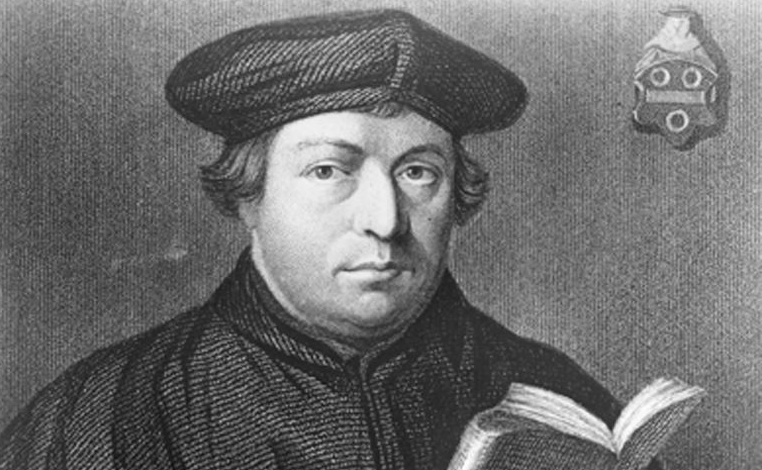
Antitheses: In this episode Clark deploys several antitheses, of character and society, to illuminate the history of the Reformation and its impact on Western civilisation. As he points out, the peak of Renaissance brilliance proved to be fleeting:
The dazzling summit of human development represented by Michelangelo, Raphael and Leonardo lasted for less than 20 years. It was followed by a time of uneasiness often ending in disaster. For the first time since the great thaw civilised values were questioned and defied, and for some years it looked as if the footholds won by the Renaissance ~ the discovery of the individual, the belief in human genius, the sense of harmony between man and his surroundings ~ had been lost.
Character: What drove this drastic shift in consciousness? According to Clark, it had something to do with “the character of northern man at the end of the 15th century.” This exhibited admirable qualities of industry, purposefulness, tenacity, earnestness, a serious personal piety and approach to life, a belief in truth and a desire to pursue it, and impatience with pretence and compromise.

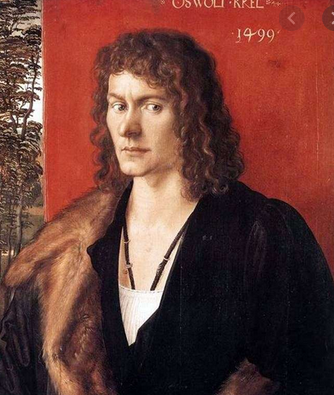 Hysteria & Religious Fervour: But, in addition to these positive qualities, Clark believes the Germanic peoples exhibited a “more dangerous characteristic, a vein of hysteria,” and he believes this can be illustrated by comparing two portraits: Raphael’s Portrait of a Cardinal, (left) and Albrecht Dürer’s Oswald Krell (right). For Clark,
Hysteria & Religious Fervour: But, in addition to these positive qualities, Clark believes the Germanic peoples exhibited a “more dangerous characteristic, a vein of hysteria,” and he believes this can be illustrated by comparing two portraits: Raphael’s Portrait of a Cardinal, (left) and Albrecht Dürer’s Oswald Krell (right). For Clark,
the cardinal is not only a man of the highest culture but balanced and self-contained
whereas Krell
is on the verge of hysteria, with those staring eyes, self-conscious introspection and uneasiness.
One man, Clark seems to be saying, is comfortable with civilisation; the other man tends always towards its antithesis.
Obedience vs Will: Moving from the psychological to the sociological, Clark goes on to invoke a distinction made by H. G. Wells:
…between communities of obedience and communities of will; the first produced the stable societies like Egypt and Mesopotamia, the original homes of civilisation; while the second produced the restless nomads of the north.
The Medieval community was one of obedience, while the Reformation was driven by a community of the will, by
men who owed nothing to the past ~ to whom it meant no more than an intolerable servitude. And so Protestantism became destructive, and, from the perspective of those who love the visual arts, an unmitigated disaster.
Iconoclasm: Protestantism was a disaster for art, according to Clark, because it initiated a massive and prolonged attack of iconoclasm ~ the wholesale destruction of images. Innumerable works of art, e.g., paintings, sculptures, stained glass windows, were systematically destroyed in orgies of violence, eradicating centuries of Europe’s cultural heritage. In Clark’s view,
the motive wasn’t so much religious as an instinct to destroy anything comely, anything that reflected a state of mind that an uncivilised man couldn’t share. The existence of such incomprehensible values enraged them.
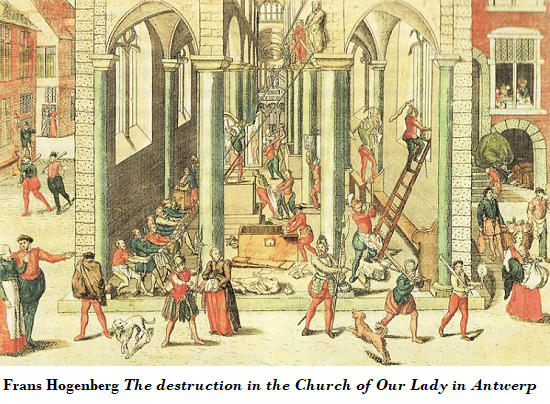
A Cultural Up-Rooting: Remarkably, Clark believes this cultural catastrophe was necessary:
It had to happen. If civilisation was not to wither, or petrify, like the society of ancient Egypt, it had to draw life from deeper roots than those that had nourished the intellectual and artistic triumphs of the Renaissance.
He seems to be claiming that the Renaissance was ultimately superficial and remained rooted in the community of obedience dominated by the Church; and that what was required was the comprehensive cultural up-rooting brought by the community of the will that drove the Reformation.
A Civilisation of the Word: Ultimately, out of this iconoclastic assault “a new civilisation was created ~ but it was a civilisation not of the image, but of the word.” And, as the Reformation broke out and took form, there were two masters of the word: Martin Luther and Desiderius Erasmus. Once seen as allies, their eventual intellectual collision over the nature of man and potential, the human condition in the sight of God lay at the heart of the Reformation.
Luther and the Heroic Spirit: The heroic spirit so valued by Clark, had found expression in the work of Michelangelo. Now he finds it again, in Luther, who declared “Here I stand, I can do no other!” This resolve is revealed in various portraits by Cranach (below): “Luther in all his changing aspects ~ the tense spiritually struggling monk; the great theologian with the coarse peasant’s jaw and the brow of Michelangelo; the emaciated layman.”

The Wrath of God: What drove Luther, and the Reformation as a whole? Above all, Luther (and many others) had a profound sense of living under the judgement of a wrathful God. He was petrified by his perceived sinfulness. The word he used to describe these attacks, Anfechtungen, refers to spiritual isolation, despair, desolation, and desperation. He declared
So great and so much like hell that no tongue could adequately express them, no pen could describe them, and one who had not himself experienced them could believe them
Luther had become a monk to deliver himself out of this terror and into God’s good graces — and yet this strategy had failed.
Justification by Faith Alone: Then, in one flash of insight, Luther was released from his torment. He realized that the Church had lost sight of the central truth of Christianity — the doctrine of justification by faith alone, by which God declared a sinner righteous through the latter’s faith in Jesus Christ. This was a defining experience of metanoia: a transformative change of heart and a spiritual conversion, after which everything looks different and nothing can ever be the same. This is a phenomenon found in many religious traditions, and when it occurs on a mass scale it brings revolutionary upheavals.
The Leader-in-Waiting: This happened in Germany, because Luther was
the leader for which the earnest German people is always waiting,” and, “unfortunately for civilisation he not only settled their doubts and gave them the courage of their convictions; he also released that latent violence and hysteria that I mentioned earlier.
Irrationalism: And faith lay beyond the reach of reason, and so Luther unleashed a
northern characteristic that was fundamentally opposed to civilisation: an earthy, animal hostility to reason and decorum that Nordic man seems to have retained from his days in the primeval forest.
 The Tools of Thought: However, despite all this (or even compounding it!), Luther was the master of the German language who “gave his countrymen words,” translating the Bible into the vernacular and also giving his people “the tools of thought,” which were applied on a massive scale with the advent of printing (right). For all its benefits, printing fed a destructive impulse that fundamentally shaped the destiny of Europe.
The Tools of Thought: However, despite all this (or even compounding it!), Luther was the master of the German language who “gave his countrymen words,” translating the Bible into the vernacular and also giving his people “the tools of thought,” which were applied on a massive scale with the advent of printing (right). For all its benefits, printing fed a destructive impulse that fundamentally shaped the destiny of Europe.
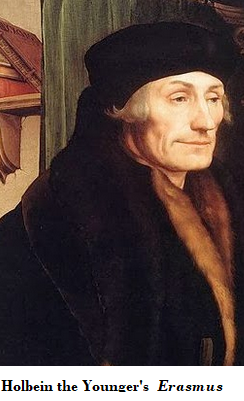 Erasmus, Prince of Humanists: ‘The Prince of the Humanists’, Erasmus of Rotterdam was a pioneering scholar of the Bible and the Church Fathers, the Classics, ancient languages and literature. He was also a firm advocate of reason; an influential Christian moralist; a critic of clerical abuses; and an advocate of a simple but inwardly rich Christian piety. For Clark, he also exhibited the “internationalism” that could have offset the “destructive national characteristics” of the Germans and other northern peoples.
Erasmus, Prince of Humanists: ‘The Prince of the Humanists’, Erasmus of Rotterdam was a pioneering scholar of the Bible and the Church Fathers, the Classics, ancient languages and literature. He was also a firm advocate of reason; an influential Christian moralist; a critic of clerical abuses; and an advocate of a simple but inwardly rich Christian piety. For Clark, he also exhibited the “internationalism” that could have offset the “destructive national characteristics” of the Germans and other northern peoples.
A Moderate: He was above all a moderate and a gradualist, believing that the many problems plaguing Christendom arose from immorality and ignorance, and that they could be addressed through gradual moral improvement produced by scholarship and education. Clark believes he spoke for many people who “yearned for tolerance and reason and simplicity of life ~ in fact, for civilisation.” However, confronted with the unimaginable “tide of fierce emotional and biological impulses unleashed by Luther and the Reformation they were powerless.”
Erasmus & the Reformation: Nevertheless, as the Reformation got underway Erasmus and Martin Luther were seen as natural allies in their demands for Church reform. Indeed, for some time it was assumed that Luther was a follower of Erasmus and a fellow moderate. As Clark notes, Dürer pleaded
“O Erasmus of Rotterdam, where wilt thou take thy stand [and] obtain the martyr’s crown?”
However, events unfolded far more quickly and in a much more radical direction than Erasmus or his supporters (or even Luther) could ever have imagined. Appalled and very frightened, and with no interest in becoming a martyr, Erasmus disassociated himself from the Reformation in the early 1520s, much to the disgust of the Reformers, who’d idolized him.
Erasmus vs Luther: It was at this point that Erasmus initiated one of the great polemical and revealing debates of the Reformation era. The Freedom of the Will (1524) attacked what Erasmus saw as the errors and extremism of Luther’s view of predestination, free will, and God’s grace. Luther in turn responded with On the Bondage of the Will (1525), which re-asserted his bleak view of human sinfulness and helplessness. This became a key text in Reformation theology.
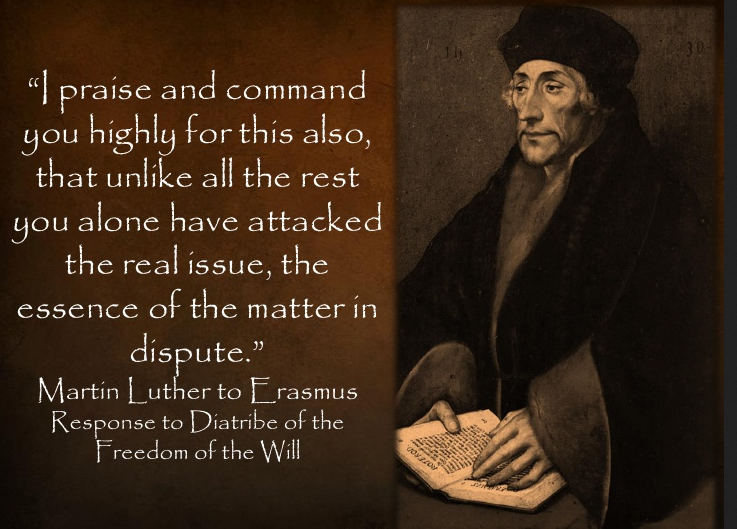
The Freedom of the Will: Erasmus reflected the Christian Humanist conviction that people possess free will, and that key doctrines like repentance, baptism, conversion, and the ideal of a Christian life depend on this and make no sense without it. Erasmus argued that if people had no free will, then God’s commandments and the teachings contained in the Bible would have no point. Instead, he insisted, God had deliberately endowed humanity with free will and rewarded or punished them according to the choices they made. Erasmus also argued that if people’s sinful acts and their consequences were in fact predestined by God, then God would appear to be a cruel and inscrutable tyrant who punishes his creatures for sins he had predestined them to commit.
On the Bondage of the Will: Luther’s response to this reflected an entirely different outlook that was virtually the antithesis of Humanism. In his view, sinful human beings, living in a world saturated with sin and under the reign of Satan, are utterly incapable to exercising any genuine free will at all. Luther also saw nothing 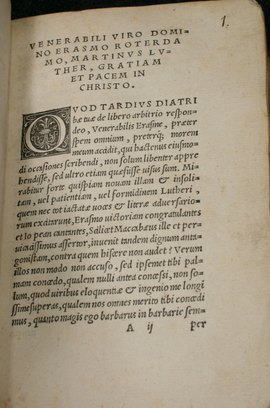 at all attractive about the idea of free will: for him it was synonymous with ‘wilfulness’. Consequently, nobody can achieve redemption through their own choice, on the contrary, they are naturally pre-disposed to wickedness, willing only evil, and any steps that they may take towards salvation are simply the result of God extending his grace to them and turning their will towards redemption. Were this not the case, Luther insisted, then God’s total omnipotence and sovereignty over His creatures and creation would be compromised.
at all attractive about the idea of free will: for him it was synonymous with ‘wilfulness’. Consequently, nobody can achieve redemption through their own choice, on the contrary, they are naturally pre-disposed to wickedness, willing only evil, and any steps that they may take towards salvation are simply the result of God extending his grace to them and turning their will towards redemption. Were this not the case, Luther insisted, then God’s total omnipotence and sovereignty over His creatures and creation would be compromised.
Rupture: Ascribing this latter view to Erasmus (right), Luther declared that the great Humanist was not even a Christian. From the perspective of Luther’s rigorous theology, there was something about the Gospel message that Erasmus just didn’t get: that human beings are saved not by their own free will (which doesn’t exist) but solely by the grace of God. On the other hand, from Erasmus’s perspective, Luther’s theology led to terrifying conclusions about God and humanity that seemed to leave people nowhere to go as they sought salvation under the baleful eye of an inscrutable and wrathful God.
Age of Extremes: And so it became an unforgiving age of extremes. Erasmus and other moderates were swept aside as the revolutionary fervour of the Reformers propelled them into war against the institutional might of an increasingly intransigent Catholic Church. Thus was launched the Age of Religious Wars, lasting 120 years, in which even a “noble idealist” like Sir Thomas More could be swept up into the political and religious turmoil — “a world of action where he sometimes lost his way,” and eventually his head! As Clark observes, “it shows how quickly civilisation can appear and disappear that the author of Utopia should have met such a fate.
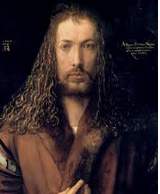 Albrecht Dürer: One great witness to the onset of this calamity was Albrecht Dürer (left), an artist of brilliance whose curiosity and eye for detail Clark compares to Leonardo da Vinci. He was “an absolute master of technique,” whose inspired use of perspective gave his engravings and woodcuts an impressive sense of reality.
Albrecht Dürer: One great witness to the onset of this calamity was Albrecht Dürer (left), an artist of brilliance whose curiosity and eye for detail Clark compares to Leonardo da Vinci. He was “an absolute master of technique,” whose inspired use of perspective gave his engravings and woodcuts an impressive sense of reality.
Divine Self-Love: “Intensely self-conscious and inordinately vain,” Dürer’s self-portraits are “masterpieces of self-love,” and he wasn’t above “portraying himself in the traditional pose and likeness of Christ.” Believing creative genius to be a divine quality, “he paid homage to it by depicting himself as God.”
Melancholia (a detail of which is below) Dürer was “immersed in the intellectual life of his time,” and he combined this with his deep interest in “the mystery of the human psyche” to “produce one of the great prophetic documents of western man.” This was the engraving he called Melancholia I.
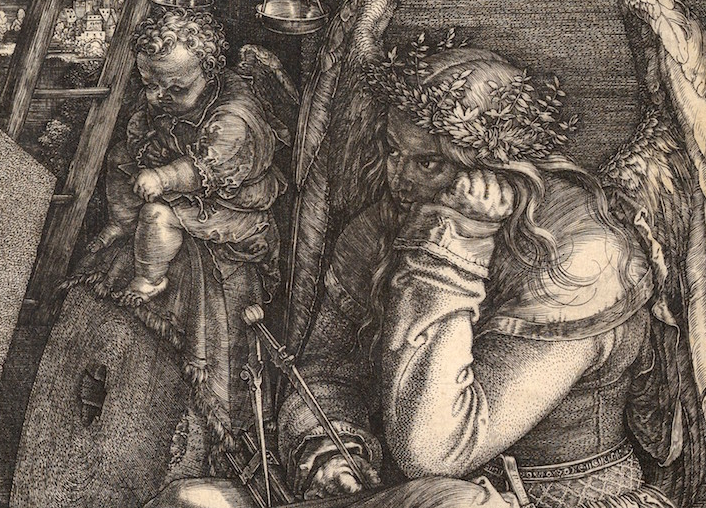
The central figure is “humanity at its most evolved, with wings to carry her upwards.” But her attitude is anything but triumphant or promethean; rather it seems to indicate resignation or even defeat. In her hands and scattered around her are the instruments of measurement and emblems of constructive action, and yet “she sits there brooding on the futility of human effort.”
Psychic Disturbance: Clark believes “her obsessive stare reflects some deep psychic disturbance”, and he observes that
the German mind that produced Dürer and the Reformation also produced psychoanalysis
— a science that penetrated deep into the psyche and revealed powerful, antagonistic forces.
Apocalypse: Clark recalls the various “enemies of civilisation,” and concludes:
“Well, here, in Dürer’s prophetic vision, is one more way in which it can be destroyed ~ from within!”
Stampeding towards western civilisation were Dürer’s horsemen of the Apocalypse, heralding the Wars of Religion, and the carnage to come.
Montaigne: How can one survive in such a world? “What could an intelligent, open-minded man do in mid-16th century Europe?” That was the question faced by Michel de Montaigne; his answer? –
“Keep quiet, work in solitude, outwardly conform, inwardly remain free.”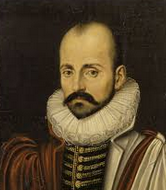
And so was born “a figure new to European civilisation: the intellectual recluse.” Montaigne (right) was “the greatest Humanist of the mid-16th century,” but he turned his back on politics, embraced introspection, and “retreated into his tower,” where he invented the essay, “the accepted form of Humanist communication.”
Elizabethan England: Montaigne’s “egocentric isolation [and] self-searchings marked the end of the heroic spirit of the Renaissance,” but perhaps only on the continent, because Elizabethan England provided something of a safe-haven, albeit “brutal, unscrupulous and disorderly.”
A Kind of Civilisation: Clark concedes
it is debatable how far Elizabethan England can be called civilised … But if the first requisites of civilisation are intellectual energy, freedom of mind, a sense of beauty and a craving for immortality, then the age of Marlowe and Spenser, of Dowland and Byrd, was a kind of civilisation.
Above all, it produced the towering genius of William Shakespeare.
Complete Scepticism: Clark only touches on Shakespeare, stressing how he gave voice to the intellectual mood that had descended upon the age:
In his freedom of mind, in his power of self-identification, in his complete absence of any dogma, in his complete and uncomfortable scepticism, Shakespeare sums up and illuminates the piece of history that I have just described.
‘Man delights not me’: Of The Bard, Clark observes
Shakespeare must be the first, and may be the last, supremely great poet to have been without religious belief, even without the Humanist’s belief in man.
Clark then quotes Hamlet’s famous soliloquy, which gives dramatic expression to the melancholia that Dürer sought to capture in his similarly famous image.
First the world is dismissed:
‘I have of late, (…) lost all my mirth, forgone all custom of exercises; and indeed, it goes so heavily with my disposition; that this goodly frame the earth, seems to me a sterile promontory; this most excellent canopy the air, look you, this brave o’er hanging firmament, this majestical roof, fretted with golden fire: why, it appeareth no other thing to me, than a foul and pestilent congregation of vapours.’
And then Man is consigned to oblivion:
‘What a piece of work is man, How noble in reason, how infinite in faculty, In form and moving how express and admirable, In action how like an Angel, In apprehension how like a god, The beauty of the world, The paragon of animals. And yet to me, what is this quintessence of dust? Man delights not me.’
Absolute Meaninglessness: Reflecting on this grim outlook, Clark observes:
There have been great pessimists since Shakespeare’s time, but who else has felt so strongly the absolute meaninglessness of human life?
And here, Clark quotes Macbeth:
To-morrow, and to-morrow, and to-morrow,
Creeps in this petty pace from day to day,
To the last syllable of recorded time;
And all our yesterdays have lighted fools
The way to dusty death. Out, out, brief candle!
Life’s but a walking shadow, a poor player
That struts and frets his hour upon the stage
And then is heard no more. It is a tale
Told by an idiot, full of sound and fury
Signifying nothing.
Outstaring the Emptiness: As Clark laments of such thoughts:
How unthinkable before the break-up of Christendom, the tragic split that followed the Reformation.
But he concludes with a peculiar optimism:
And yet I feel that the human mind has gained a new greatness by outstaring this emptiness.”
And so we look forward to the next episode
APPENDIX: THE PRINTING REVOLUTION
Invention: The invention of printing is generally regarded as one of the greatest events in history. Johannes Gutenberg (c.1397-1468) was a goldsmith who drew on his expertise in metalwork and the use of local winepresses to invent an innovative printing machine that introduced a key innovation – movable metal type. Gutenberg and his business partners built the large Gutenberg Press around 1450. Their projects included the famous Gutenberg Bible, published on September 30, 1452, which was the first book to be published in large numbers.
The Gutenberg Bible: This Bible consisted of 1,282 pages in two volumes. It needed 20 staff and Gutenberg cast 290 different type shapes. The colorful initials and decorations were added later by an illuminator. Of the 180 copies printed, 30 were printed on exquisite parchment and the rest on paper. Today, 48 copies remain in existence. This Bible proved that a printed work was aesthetically equal to hand-written works, and it remains today one of the most beautifully printed books in the world.
Importance of Luther: The key decision was the shift in publishing away from luxury printed books like the Gutenberg Bible to inexpensive pamphlets like those produced by of Martin Luther and his supporters. Luther proved to be a brilliant writer and the success of the Reformation was indebted to the millions of printed copies of religious pamphlets and tracts that took his arguments to the people. There was an insatiable popular demand that only grew with each new twist in the deadly conflict. As a result, Luther’s works accounted for around one-third of all German works sold between1518 & 1525.
The Impact of Pamphlets: It proved a very lucrative business and printers were prepared to risk drastic punishment, including the death penalty, in order to meet the demand. Consequently, in the 1520s alone about 630 different pamphlets were printed. The vast majority was in German, about 14-40 pages long, with their text supported by often extremely vivid engravings and woodcut prints, produced by artists including Albrecht Dürer.
Pamphlets & Preaching: These pamphlets were read not only by the literate laity, they also provided the basis of the sermons delivered by an army of preachers who supported Luther: “Through them there occurred the first mass movement of religious change backed by a new technology” (A.G.Dickens, The German Nation and Martin Luther, p.103).
Religious Texts: About half of the mass of literature published before 1500 was religious in character: Bibles, books, manuals, breviaries, catechisms, collections of sermons, works of philosophy and other texts. Later, Luther published his German Bible and this vernacular text sold 200,000 copies during the 16th century, even though they cost the equivalent of three weeks wages for a skilled worker.
Rapid Adoption of Printing: The new printing press technology spread quickly around Europe: to Basel by 1466; Rome by 1467; Paris and Pilsen by 1468; Venice by 1469; Leuven, Valencia, Cracow, and Buda by 1473; Westminster by 1476; and Prague by 1477. By 1500 there were presses operating in more than 250 locations,
Madam: Archbishop Fisher (July-August 2024) does not resist the attacks on his church by the political, social or scientific atheists and those who insist on not being told what to do.
Aug 29 2024
6 mins
To claim Aborigines have the world's oldest continuous culture is to misunderstand the meaning of culture, which continuously changes over time and location. For a culture not to change over time would be a reproach and certainly not a cause for celebration, for it would indicate that there had been no capacity to adapt. Clearly this has not been the case
Aug 20 2024
23 mins
A friend and longtime supporter of Quadrant, Clive James sent us a poem in 2010, which we published in our December issue. Like the Taronga Park Aquarium he recalls in its 'mocked-up sandstone cave' it's not to be forgotten
Aug 16 2024
2 mins







